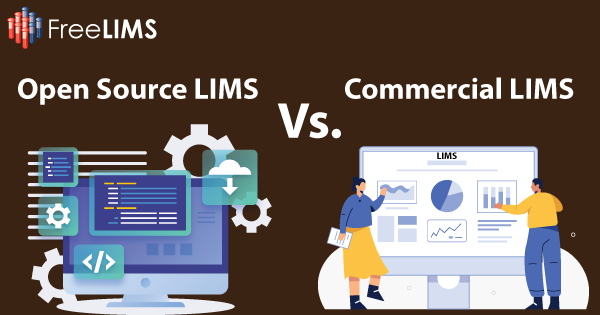Laboratory Information Management Systems (LIMS) play a pivotal role in today’s laboratories across multiple industries. They facilitate data management, sample tracking, and workflow automation, making laboratory operations more efficient. When it comes to LIMS, you have two primary options: open-source and licensed solutions. Let’s start with the basics. If you’re new to LIMS or need a refresher, you can check out our previous blog post titled “What is a LIMS” for a foundational understanding of LIMS, which will set the stage for our discussion on choosing the right LIMS for your laboratory.
Delineating Open Source LIMS
Open source LIMS is a type of software that is accessible to the general public without cost and can be modified and shared by anyone. It provides access to the underlying source code, and hence, anyone can view and modify the code. The open-source nature of such systems encourages collaboration among developers, researchers, and laboratories. Multiple individuals or organizations can work together to improve and enhance the software, leading to rapid development and innovation. These systems are typically built and maintained by a community of developers.
Here are some key points to take into account while considering an open source LIMS:
Cost: Open source LIMS solutions are generally free, which can be a significant advantage for laboratories working on a budget. However, it’s essential to account for potential costs associated with customization, support, and maintenance.
Customization: An open source LIMS provides the flexibility to customize the system to meet your lab’s specific needs. This can be a substantial benefit for laboratories with unique workflows and processes.
Community Support: These systems boast a committed group of users and developers ready to offer help, exchange information, and actively participate in continuous improvement efforts.
Upkeep and Maintenance: While open source software can be cost-effective initially, it may require more effort to maintain, update, and ensure security compared to licensed options.
Understanding Commercial or Licensed LIMS
Commercial LIMS, on the other hand, is a proprietary software developed and sold by a vendor. Here are the key aspects to consider when opting for a licensed LIMS:
Cost: Commercial LIMS solutions typically involve upfront costs in the form of licensing fees, implementation fees, and ongoing support fees. However, these costs can be predicted and budgeted for.
Vendor Support: Commercial LIMS often come with dedicated customer support, which can be valuable for troubleshooting issues and receiving regular updates and enhancements.
Regulatory Compliance: Commercial LIMS systems often offer built-in features for regulatory compliance, making it easier for laboratories operating in regulated environments to meet requirements.
Security: Commercial LIMS vendors often invest in robust security measures to protect sensitive data. This can be crucial for laboratories dealing with confidential information. Licensed LIMS vendors often invest in establishing strong security measures aimed at safeguarding sensitive data, a critical aspect for laboratories handling confidential information.
Customization: It’s important to determine whether the licensed LIMS can be configured or customized to accommodate your unique workflows and data management processes. This can be important to adapt the system to your specific needs.
Data Migration: If you’re transitioning from an existing system, consider the ease of data migration into the new LIMS. Data migration can be a complex and critical process. Zero in on a vendor that can offer data migration services at no additional cost.
Choosing the Right LIMS for Your Laboratory
The decision between open source and commercial LIMS ultimately depends on your laboratory’s specific needs, budget, and long-term goals. Here are some guidelines to help you make an informed choice:
Budget: If you have limited financial resources, open source LIMS may be the way to go. However, be prepared to invest in customization and ongoing maintenance.
Customization Requirements: If your laboratory has unique processes and workflows, open source LIMS offers the flexibility needed to tailor the system to your exact needs. However, some LIMS vendors now offer highly configurable LIMS systems that can be easily adapted to your laboratory workflows without involving IT personnel. Understand the pros and cons of a configurable LIMS and a customizable LIMS, then zero in on the right LIMS solution.
Regulatory Compliance: If your laboratory operates in a regulated environment, a commercial LIMS may be better equipped to handle compliance requirements effectively.
Security and Support: Consider the level of support and security your laboratory requires. Licensed LIMS vendors often provide dedicated support and robust security features.
Long-Term Vision: Think about your laboratory’s long-term growth and scalability. A licensed LIMS may offer a more predictable and scalable solution.
Integration: It’s important to assess the LIMS’ ability to integrate with other laboratory instruments, software, and systems you currently use or plan to adopt in the future. Seamless integration can streamline data transfer and improve efficiency by digitally transforming your laboratory.
Conclusion
In the debate between open source and commercial LIMS, there is no one-size-fits-all answer. Each type of LIMS has its pros and cons. The right choice depends on your laboratory’s unique circumstances and priorities. It’s important to thoroughly evaluate your requirements, budget, and long-term goals before making a decision. FreeLIMS is a free and highly configurable solution that can be a great starting point for many laboratories, providing an opportunity to experience the benefits of LIMS without the upfront cost. It’s hosted in the cloud for easy access to large datasets and offers reliability, security, scalability, and regulatory compliance support.


